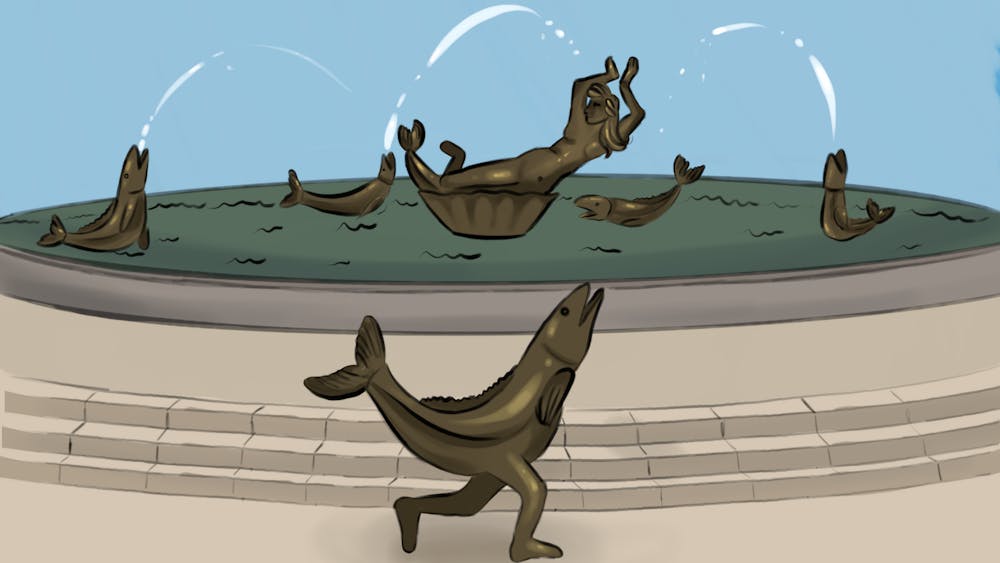The African American Dance Company performed its spring concert Saturday night in front of a near-capacity crowd at Buskirk-Chumley Theater.
“Connection Not Found,” a dance performance that critiques social media’s sway over society, kicked off the student dance collaborations. These collaborations are dance performances choreographed by groups of four or five students that show the audience how the different student groups interpreted the theme of confinement.
Five of the company’s dancers shifted from pose to pose with each beat mimicking someone taking a selfie.
Throughout their routine, the students showed how the need to stay connected to social media overpowers those who seek to maintain their individuality.
Michele Bales, a local resident and IU alumna, found that the background visuals during this collaboration contributed well to the routine’s message.
“I really liked how they incorporated national maps of cell-phone connection lines while they confronted how people are overusing their cellphones,” Bales said.
As applause died down, a second collaboration named “A Man’s World” began. They aimed to empower women to overcome male privilege.
Two pairs of dancers portrayed the power struggle between men and women as the male dancer attempted to force the female dancer to mimic his steps and dance with him. While the men tried time and again to draw the women in, the women did not succumb to perceived male dominance and continued to dance independently, not letting themselves be confined by society’s expectations to follow in men’s footsteps and be obedient.
“Unredeemed,” the third collaboration, began more mysteriously than the others as at first the audience sat quietly and watched dancers traverse the stage individually.
The music picked up, and the meaning behind the performance became apparent as one member of the group transformed two of the others into his hardened followers, and their previous independence was replaced by undying obedience to the male dancer. They then proceeded to overwhelm the fourth and final member in a representation of how the prison system can further corrupt those that at first had a chance to turn their life around.
Next, students in elaborate costumes used the idea of a “Tattered Circus” to portray the undying nature of injustice.
As compelling visuals of blood and chaos was shown behind them, one dancer acted as a devilish ring master to symbolize injustice. While most of the performance consisted of the ring master oppressing the other dancers through forced movements and positioning on stage, the dancers demonstrated how while one injustice can be conquered, another can take its place.
One of the oppressed dancers murdered the original ring master, and then began committing the same deceitful actions done by the previous ring master.
Bob Ralston, a local resident, was now halfway through his third viewing of the African American Dance Company.
“The visual backdrops really helped me understand the anger that was going on,” Ralston said. “Especially during the circus part, when the ring master’s death was paired with a bloody background on stage.”
Iris Rosa, director of the African American Dance Company, chose to make the show’s second half a call to action. She took pertinent issues and symbolized the challenge to rise above the them as a community.
The Ghanaian religious dance “Fume Fume,” performed by a mix of guest artists and company members, showed that while evil forces can try to break people apart, unity can help them through the difficult times.
After bringing up more issues of oppression and pondering if the Statue of Liberty and its ideals are being upheld, Rosa employed the music of Marvin Gaye, his songs “Save the Children” and “Inner City Blues” urging people to acknowledge the persisting fight against oppression.
The performance ended when Rosa reiterated through choreographed dance the importance of community and its benefits.
Audience member Donnika Berryhill said the second half of the show had a more positive spin.
“It was much more upbeat and had a lot of positive vibes,” Berryhill said.
As the crowd applauded the company and rose to a standing ovation as Rosa walked on stage, Rosa did not hesitate to put the praise squarely on the students.
“I don’t know what to say,” Rosa said addressing the company. “But from my heart, great show tonight.”





